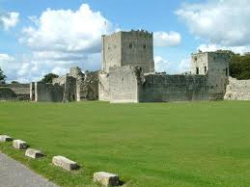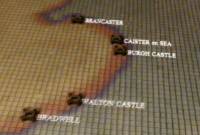Shore Forts
Andrew Pearson
Britain AD: King Arthur’s Britain

Portchester Castle
On the south coast of Hampshire, at the entrance to a natural harbour, is one of the best preserved Roman buildings in Britain.
This is Portchester Castle, one of a series of coastal forts built by the Romans in the third and fourth centuries.
They are known as Saxon shore forts because it’s still widely accepted that they were constructed to keep out marauding Anglo-Saxons from the other
side of the Channel. But, in actual fact, they may have been used for a very different purpose.
In total, 11 shore forts skirt the southern and eastern coast. From Portchester in the South, around the coast, these Shore forts have been taken
as an imposing reminder of the Anglo-Saxon threat, all the way up to Brancaster in Norfolk. One of the most easterly of these forts – Burgh Castle
– still commands the landscape.
Andrew Pearson “All of this, all the fields over there… Would have been what was termed the Great Estuary – open water, Marsh, tidal creeks
– probably until the 12th century.”
Andrew Pearson has been re-examining the forts and has come to the conclusion that they may have nothing to do with Anglo-Saxons.

Andrew Pearson

Shore Forts
Andrew Pearson “The traditional view is that they are defence against readers from across the Channel, from the peoples who are, in later
periods, going to colonise Britain.”
The name Saxon shore fort actually comes from a Roman military list which was translated in the 16th century by famous antiquarian William Camden.
What the term Saxon refers to is unclear.
Andrew Pearson “What Camden said pretty much went as archaeological fact for many centuries to come. What he hit on was a very evocative idea.
It’s very dramatic and very simple. That these forts are put up as defence against the Saxons. This is called ‘the county of the Saxon shore’.
If that means being attacked by the Saxons or settled by the Saxons, we don’t know.”
Andrew has found that the huge walls are better suited to protecting goods kept inside the forts rather than attacking enemies from outside.

Defensive Walls
Andrew Pearson “I think these sites are doing much more than defending the coastline. If the Saxons came raiding, it wouldn’t be every month, or
every year, or even 10 years, so in terms of what these forts do it’s more likely they have an economic role, perhaps a supply role, rather than
this defensive function.”
So you’re suggesting these forts could have been used to help trade from out of Britain rather than stop people coming in?
Andrew Pearson “Yes, rather than blocking access to the interior, in fact these are quite the opposite insofar as goods are coming here and then
being shipped out beyond into the Empire.”
Andrew has found no evidence that these forts were built to defend against an Anglo-Saxon invasion. So what is the evidence for invasion?



